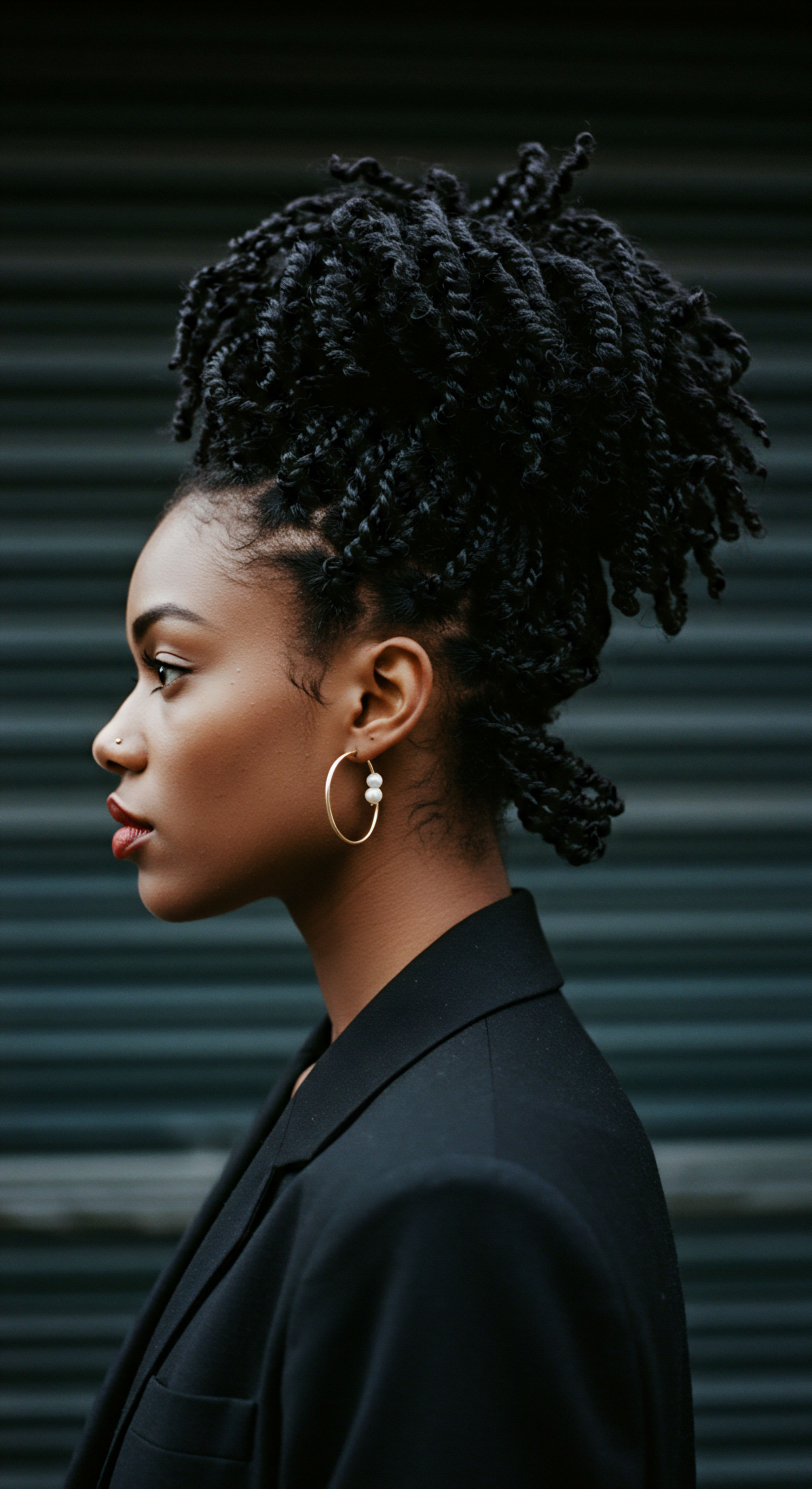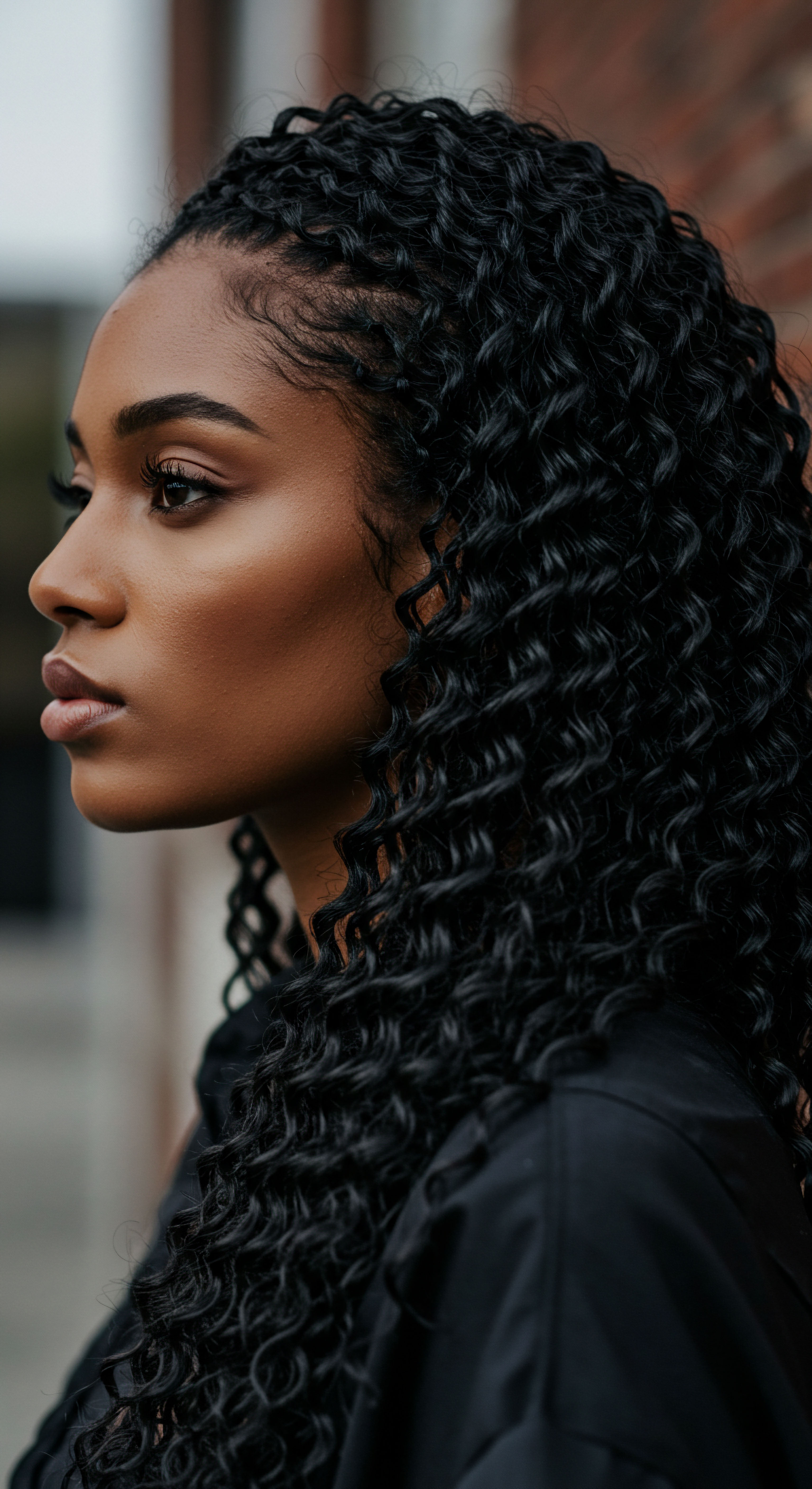
Roots
The very air we breathe, so often an unseen companion, holds a secret conversation with our textured strands. For those of us with curls, a shift in the atmosphere often signals a quiet transformation of our carefully coaxed coils. That serene definition, so lovingly cultivated, can soften, expand, and sometimes seem to simply vanish, leaving behind a halo of unruliness.
This atmospheric dialogue, particularly in climates heavy with moisture, speaks to the very architecture of hair, a dance of chemistry and environment. To truly comprehend this interaction, we must look to the core structure of each strand, a marvel of natural engineering.

Hair’s Inner World
Each individual hair, seemingly delicate, holds a complex internal arrangement. At its outermost boundary, the cuticle forms a protective shield, composed of overlapping scales. Beneath this, the cortex makes up the bulk of the hair fiber, containing bundles of keratin proteins.
These proteins, the building blocks of hair, are held in their unique configuration by various chemical bonds. Among these, the disulfide bonds provide lasting strength and determine the hair’s natural curl pattern, remaining largely unaffected by environmental moisture.
More transient, yet equally vital, are the hydrogen bonds. These weaker connections within the keratin proteins give hair its temporary form, allowing for styling changes with water or heat. Every time hair dries, these hydrogen bonds reform, holding the new shape until moisture re-enters the picture. This inherent sensitivity of hydrogen bonds to water is at the heart of how our curls react to the air’s moisture content.
The atmospheric presence of water molecules engages in a delicate, yet powerful, conversation with the internal architecture of hair.

The Hygroscopic Nature of Hair
Hair possesses a remarkable quality ❉ it is hygroscopic. This term describes its tendency to absorb moisture directly from the surrounding air. When the air carries a substantial amount of water vapor, as it does in humid climates, hair acts like a thirsty recipient, drawing in these airborne water molecules. This absorption causes the hair shaft to swell, a phenomenon measurable and quite significant.
Research indicates that at 100% relative humidity, hair can swell, increasing its diameter by almost 14%. This swelling directly influences the hair’s appearance and how curls hold their shape.
This capacity for water uptake is not uniform across all hair types or even along a single strand. Hair that has experienced chemical treatments, such as coloring or heat styling, often becomes more porous, meaning its cuticle layers are more lifted or compromised. Such hair will absorb moisture more readily, behaving like a sponge, which can lead to a greater loss of curl definition and an increase in unruliness in damp conditions.
| Relative Humidity Level Low (Below 30%) |
| Observed Hair Response Dry, static, potential for flyaways, styles hold longer. |
| Primary Mechanism Limited water absorption, strong internal hydrogen bonds. |
| Relative Humidity Level Normal (30-50%) |
| Observed Hair Response Natural texture, standard style retention. |
| Primary Mechanism Balanced moisture exchange with the environment. |
| Relative Humidity Level High (50-70%) |
| Observed Hair Response Increased volume, softening of definition, frizz potential. |
| Primary Mechanism Significant water absorption, hydrogen bond disruption, cuticle lifting. |
| Relative Humidity Level Extreme (Above 70%) |
| Observed Hair Response Unmanageable, pronounced frizz, minimal style retention. |
| Primary Mechanism Excessive water absorption, widespread hydrogen bond breakage, considerable swelling. |
| Relative Humidity Level Hair's reaction to humidity is a direct consequence of its hygroscopic nature and the behavior of its internal bonds. |

How Does Hair Porosity Shape Its Humidity Response?
The cuticle, the hair’s outermost layer, plays a central role in how much moisture enters or leaves the hair shaft. In healthy, low porosity hair, the cuticle scales lie flat and close, offering more resistance to water absorption. This means such hair may take longer to wet and dry, and products might sit on the surface rather than absorbing quickly. While it can still react to humidity, the effect might be less dramatic, sometimes resulting in hair feeling weighed down or losing volume rather than expanding with frizz.
Conversely, high porosity hair, often a characteristic of textured hair types or hair that has been chemically treated or damaged, has more lifted or gaps in its cuticle layer. This allows water molecules to enter the hair shaft with greater ease. When high porosity hair encounters a humid climate, it rapidly absorbs moisture from the air, causing the hair shaft to swell unevenly and the hydrogen bonds that maintain curl definition to break and reform haphazardly. This leads to the familiar phenomenon of curls expanding and losing their distinct shape, often appearing frizzy.

Ritual
As the atmosphere shifts, our approach to caring for textured hair must also adapt. The desire for well-defined curls, for strands that honor their inherent coil, often guides our daily practices. Understanding the science behind humidity’s touch on hair invites us to consider how our choices in care can work in concert with the environment, rather than against it. This journey towards lasting definition in the face of moisture involves a gentle wisdom, a mindful selection of techniques and products that respect hair’s delicate balance.

Product Choices and Atmospheric Moisture
The ingredients within our hair care products hold a particular sway over how hair responds to atmospheric moisture. Some ingredients, known as humectants, draw water from the air. These can be allies in drier climates, pulling moisture into the hair to keep it supple. Yet, in humid conditions, these very ingredients can become counterproductive, drawing too much moisture into the hair shaft, leading to swelling and a loss of curl definition.
Conversely, anti-humectants and emollients work to seal the hair’s outer layer, creating a barrier that helps prevent excessive moisture absorption. These are often the preferred companions in high humidity, assisting in maintaining the integrity of the curl pattern. A careful reading of ingredient lists, therefore, becomes a form of seasonal adaptation, a quiet ritual of preparation for the day’s atmospheric dance.
Selecting hair care products with mindful consideration of the environment’s moisture levels is a subtle art of preservation.

Preparing Hair for Humid Climates
To preserve curl definition when the air is heavy with moisture, certain practices become particularly beneficial. The aim is to help hair resist absorbing excess water while retaining its internal hydration.
- Adequate Hydration ❉ Hair that is already well-hydrated is less likely to desperately seek moisture from the atmosphere. Regular deep conditioning and moisturizing routines establish a strong internal moisture balance. This satiated state means there is less room for airborne water to enter and disrupt the hair’s structure.
- Sealing the Strands ❉ Applying a light oil or a styling product with sealing properties after moisturizing can help to close the cuticle, forming a protective layer that deters moisture absorption. This acts as a gentle shield against the external environment, helping curls remain distinct.
- Styling Techniques ❉ Certain styling methods can support curl definition in humid conditions. Using products that offer a strong, flexible hold can help to set the curl pattern, making it more resilient to atmospheric changes. Air drying or using a diffuser on a low setting can also help set curls without adding undue stress.

What Role Do Hair Products Play in Managing Curl Definition?
Hair products serve as more than just styling aids; they become active participants in the hair’s interaction with its environment. Products containing film-forming polymers, for example, create a thin, invisible layer around each strand. This film can help to hold the curl pattern in place and act as a buffer against external humidity, preventing the rapid exchange of water molecules that leads to frizz and loss of definition. These polymers often work by creating a physical barrier, limiting the hair’s direct exposure to the moisture-laden air.
The choice of cleanser and conditioner also plays a role. Using gentle, sulfate-free cleansers helps preserve the hair’s natural moisture barrier, preventing excessive dryness that could make hair more susceptible to humidity’s effects. Conditioners that provide slip and help to smooth the cuticle contribute to a more uniform surface, which can better repel external moisture. Ultimately, the cumulative effect of these product choices forms a protective strategy, supporting hair’s structural integrity against the shifting whims of the weather.

Relay
Beyond the visible expansion and softening of curls, the true interplay between textured hair and a moisture-rich climate unfolds at a molecular level, a sophisticated dialogue between water and protein. This deeper understanding reveals not merely a reaction, but a complex series of events that challenge the very architecture of hair, leading to the familiar diffusion of curl definition. Here, we peel back the layers to observe the subtle shifts and structural responses that dictate hair’s behavior in damp air.

Water’s Molecular Embrace and Hydrogen Bonds
The primary reason curls lose their defined shape in humid conditions lies in the inherent sensitivity of hair’s hydrogen bonds to water molecules. Hair’s main protein, keratin, contains countless hydrogen bonds that give it its temporary shape and flexibility. These bonds are weaker than disulfide bonds, which determine the hair’s permanent curl pattern, and are easily disrupted by water.
When the air carries high levels of water vapor, these airborne water molecules infiltrate the hair shaft. They readily form new hydrogen bonds with the keratin proteins, disrupting the existing ones that hold the curl in its desired configuration.
This molecular exchange causes the keratin chains within the cortex to reorient themselves. Instead of maintaining their tightly coiled arrangement, they absorb water, swell, and effectively “uncoil” or relax, leading to a loss of the curl’s tight, defined spiral. The outer cuticle layers, which ideally lie flat and smooth, can also lift as the hair swells, contributing to a rougher surface texture and the appearance of frizz.

The Differential Response of Hair Cortex Components
A particularly illuminating aspect of hair’s reaction to humidity lies in the uneven absorption of water by its internal components. Human hair, especially textured hair, possesses two distinct types of cortical cells ❉ the Orthocortex and the Paracortex. These two regions, while both composed of keratin, differ in their protein arrangement and disulfide bond density. The orthocortex tends to be more responsive to changes in humidity, absorbing water more readily and swelling to a greater degree than the paracortex.
This differential swelling creates internal stresses within the hair fiber. As the orthocortex expands more than the paracortex, it causes the hair strand to twist and buckle, distorting the existing curl pattern. This internal strain contributes significantly to the loss of definition, as the hair is literally fighting against itself at a microscopic level. This subtle, yet powerful, internal imbalance is a key factor in why curls, even those well-hydrated, can still succumb to the atmospheric pressure of high moisture.
The microscopic world within each hair strand holds the true story of curl definition’s surrender to humidity.
This phenomenon, where the internal components of hair react dissimilarly to environmental moisture, speaks to the complex interplay of biological structure and atmospheric conditions. It explains why a seemingly simple change in weather can yield such a dramatic effect on hair’s visible form. The hair’s mechanical properties, such as its elasticity and tensile strength, are also directly influenced by its water content.
When hair absorbs excess water, its elastic modulus decreases, making it more pliable but also less capable of holding a rigid shape. This reduced stiffness contributes to the drooping and loosening of curls.

The Role of Dew Point in Atmospheric Interaction
While relative humidity is commonly cited, the Dew Point offers a more precise measure of the absolute moisture content in the air and, consequently, a better indicator of how hair will behave. Relative humidity varies with temperature, but dew point remains constant unless the actual amount of water vapor in the air changes. A high dew point means there is a substantial amount of water vapor present, regardless of temperature, signaling an environment where curls are most likely to expand and lose definition.
Consider a scenario where the relative humidity is 90% at a cool 35°F (2°C) versus 60% at a warm 75°F (24°C). The hair’s response will be vastly different. The warmer air, even with a lower relative humidity percentage, can hold significantly more actual water vapor, leading to a higher dew point and a greater likelihood of curl disruption. This highlights the importance of observing the dew point for a more accurate prediction of hair’s atmospheric dance.
| Dew Point Range Below 35°F (2°C) |
| Atmospheric Feel Dry, crisp |
| Typical Hair Response Dryness, static, flyaways, curls may loosen. |
| Product Considerations Moisture-rich products, leave-ins. |
| Dew Point Range 35°F – 45°F (2°C – 7°C) |
| Atmospheric Feel Cool, comfortable |
| Typical Hair Response Good definition, balanced moisture. |
| Product Considerations Balanced moisture and light hold. |
| Dew Point Range 45°F – 60°F (7°C – 16°C) |
| Atmospheric Feel Comfortable, slightly humid |
| Typical Hair Response Curls often well-defined, some volume. |
| Product Considerations Moderate hold, balanced humectants. |
| Dew Point Range 60°F – 65°F (16°C – 18°C) |
| Atmospheric Feel Muggy, sticky |
| Typical Hair Response Increased volume, potential for frizz, definition softening. |
| Product Considerations Stronger hold products, some anti-humectants. |
| Dew Point Range Above 65°F (18°C) |
| Atmospheric Feel Oppressive, heavy |
| Typical Hair Response Significant frizz, loss of definition, unmanageable. |
| Product Considerations Anti-humectants, strong hold gels, minimal leave-ins. |
| Dew Point Range Understanding dew point provides a clearer compass for tailoring hair care routines to atmospheric moisture. |

The Cumulative Impact of Environmental Factors
The relationship between hair and humidity is not isolated. Temperature also plays a significant, interconnected role. Warmer temperatures mean the air can hold more water vapor, leading to higher dew points and more pronounced effects on hair. This is why summer months, often characterized by both warmth and high moisture, present the greatest challenge to curl definition.
Furthermore, hair damage, whether from chemical processes or mechanical stress, can exacerbate the issue. Damaged hair often has a compromised cuticle, making it more porous and susceptible to rapid water absorption and subsequent swelling. This creates a cyclical pattern where humidity causes damage, and damage makes hair more reactive to humidity, leading to further loss of definition and increased unruliness.
Consider a study that explored the effects of a specific organic acid on hair-set durability. Researchers found that this acid, when applied to hair, could absorb at sites where water typically binds, even in very dry conditions. By preventing water penetration and forming strong, stable hydrogen bonds with hair proteins, this organic acid suppressed the exchange of hydrogen bonds that usually leads to the breakdown of a set style.
This research points to the possibility of internal molecular stabilization as a means to resist humidity’s effects, moving beyond surface-level solutions to address the core chemical interactions within the hair fiber. This finding underscores the potential for innovative approaches that work at the molecular level to maintain curl integrity in challenging climates.

Reflection
The journey through the internal landscape of our curls, their delicate chemistry, and their spirited dance with atmospheric moisture, offers a quiet revelation. Our hair, with its inherent beauty and unique patterns, is not merely a static adornment but a living canvas, responding to the unseen forces around it. The softening of definition in humid air is not a failure of our strands, but a testament to their dynamic nature, their constant striving for equilibrium with the world.
This understanding invites a gentle acceptance, a recognition that caring for textured hair is a conversation, an ongoing practice of observation and thoughtful response. As we continue to honor the distinct character of our curls, we find not a battle to be won, but a deeper connection to be cultivated, allowing our hair to tell its story, even in the most moisture-rich climates.

References
- Robbins, Clarence R. Chemical and Physical Behavior of Human Hair. 5th ed. Springer, 2012.
- Feughelman, Max. Mechanical Properties of Keratin Fibers. Elsevier, 1997.
- Doherty, Richard F. and William T. Shore. “The Physical Chemistry of Hair.” Journal of the Society of Cosmetic Chemists, vol. 27, no. 1, 1976, pp. 29-41.
- Zuidema, P. et al. “The influence of humidity on the viscoelastic behaviour of human hair.” Biorheology, vol. 40, no. 4, 2003, pp. 431-439.
- Itou, Takashi, et al. “Study of the interaction between hair protein and organic acid that improves hair-set durability by near-infrared spectroscopy.” Journal of Cosmetic Science, vol. 57, no. 2, 2006, pp. 139-151.
- Gao, T. “Evaluation of hair humidity resistance/moisturization from hair elasticity.” Journal of Cosmetic Science, vol. 58, no. 4, 2007, pp. 393-404.
- Wortmann, F. J. et al. “Humidity-dependent bending recovery and relaxation of human hair.” Journal of Applied Polymer Science, vol. 113, no. 5, 2009, pp. 3336-3344.
- Meyers, Marc A. et al. “Structure and mechanical behavior of human hair.” Materials Science and Engineering ❉ C, vol. 66, 2016, pp. 1-13.
- Jachowicz, J. and R. McMullen. “Mechanical analysis of elasticity and flexibility of human hair.” Journal of Cosmetic Science, vol. 59, no. 2, 2008, pp. 109-122.
- Kreplak, L. et al. “Water-induced plasticity in human hair ❉ A structural analysis.” Journal of Structural Biology, vol. 147, no. 2, 2004, pp. 133-143.